REMEMBERING PIPER ALPHA

The Night That Changed Our World Pledge to Play Your Part
As we recognise the 35th anniversary of the Piper Alpha disaster which took place on the 6th July 1988, Step Change in Safety calls for an industrywide ‘Time out for Safety’ to revisit the film ‘Remembering Piper: The Night that Changed our World’. This resource was released in 2013 on the 25th anniversary of the disaster and gives an impactful account of the events of that night, serving to remind us why remaining vigilant, and Playing Your Part is so important.

Our video was voted as the most effective and impactful resource in our portfolio for reinforcing the importance of maintaining focus in safety at last year’s 25th anniversary Step Change in Safety event.
The Piper Alpha Production Platform exploded in the North Sea, killing 167 men – husbands, fathers, sons, brothers, loved ones and colleagues. It remains the world’s worst-ever offshore disaster. Within 2 hours, the Piper Alpha went from being one of the world’s most productive platforms to a burning wreckage. It left just 61 survivors.
Steve Rae, Executive Director at Step Change in Safety, arrived on board Piper Alpha that day and experienced first-hand the tragic events of that night and knows how fortunate he was to have survived. Steve uses his experience from that night to lead Step
Change in Safety and improve safety throughout the oil and gas industry.
In honour of all those who perished that night, we encourage you to take time out for safety to revisit this important film and remember and reflect on the importance of remaining vigilant at your worksite, protecting yourself and your work colleagues.
Our request is that everyone working in the oil and gas industry watches this film during the week of 3-9th July and across the rest of the month; play it at your safety meetings, circulate it with your teams and colleagues, both on and offshore.
We request respectfully that you pledge to give your time of just 22 minutes, the time it took for the disaster to unfold. Play Your Part and revisit this vital resource, share with your networks, and encourage others to watch. The video has also now been
translated into 6 different languages for the first time to encourage viewing across our growing international membership.
Visit https://www. stepchangeinsafety. net/workgroups/ major-accident-hazard/ remembering-piperalpha/ or scan the QR code to take the pledge and gain access to the video in English, French, Spanish, Norwegian, Dutch, Brazilian Portuguese and Danish.
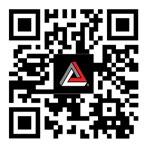

Please share your thoughts and memories and engage with us on social media using #PledgeforPiper

WELCOME FROM THE WEST TEAM
Welcome to Issue 3 of Tea Shack News Rebooted. Q3 and the month of July always serves as a poignant reminder of the anniversary of the Piper Alpha disaster. During this month’s 35th anniversary of the disaster which took place on the 6th July 1988, Step Change in Safety calls on the industry to revisit the film ‘Remembering Piper: The Night that Changed our World’. Read more about this in the cover story.
Issue 3 focuses on:
Q3 2023, Safe Lifting, p2 & p5 Working at Height and Preventing Dropped Objects
Update on the recent ESR Event p4
Engineering safety in every flight p6
‘Day in the Life’ of a ropes p7 access manager
This a reminder that Tea Shack News is the opportunity to have your voice shared with the wider industry so whether you are part of the workforce, leadership, member companies, Unions or the HSE, we want to hear from you!
If you have any ideas or stories you’d like to share with the rest of the industry, please get in touch with editor@teashack.news and we will consider them for future issues.
Our quarterly theme topics aim to address the offshore energy sector’s most common safety concerns through collections of resources which can be used by all job roles – everyone has a part to play.
Find out more about our 2023 annual themes at stepchangeinsafety.net or scan the QR code on the cover.
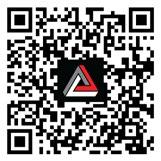
We hope you enjoy the 3rd edition of TSN Rebooted and look forward to continuing to highlight the news that matters to you. The Step Change in Safety Workforce Engagement Support Team (WEST)
Thank you for continuing to ‘PLAY YOUR PART’
2023 Q3
SAFE LIFTING, WORKING AT HEIGHT AND PREVENTING DROPPED OBJECTS

Thorough planning & hazard identification for lifting operations, working at height, & preventing potential dropped objects allows hazards to be safely managed.
Resources included in the Q3 section will help you to:
• Improve hazard awareness of routine lifting tasks and their potential to cause a major accident
• Identify and manage hazards related to working at height
• Increase awareness of potential dropped objects and their effects
This quarter’s theme is a regular focus area of health and safety teams and is equally relevant to offshore and onshore operations.
Data from Step Change in Safety’s electronic observation system (e-obs) taken from 1st Jan – 30 April 2023 identifies just how frequently these concerns arise.
When combined, cards submitted featuring line of fire, safe mechanical lifting and “other” contribute the highest number of unsafe behaviours. Examination of the “other” category show most concerns are as a result of tripping hazards, obstructions and potential dropped objects due to poor housekeeping. It is also worth noting that gravity is the second most selected hazard to date.
Our resources range from one page safety alerts to 15min videos. We encourage you to browse and share with your colleagues to help reduce the number of incidents in this area.
Find out more by scanning the QR code:
WHAT AM I?
• I was invented by the Chinese army about 2,000 years ago
• My names in the past have included “wooden ox” and “gliding horse”
• When used correctly, I can help prevent you from hurting your back

• I am typically used by almost everyone on the worksite –and even in homes!
Barrows... Be they single wheeled barrows used in the garden, or flatbed carts found at worksites, they are a valuable and often overlooked tool. Their simple design means they don’t need much maintenance or lengthy training courses to explain how they operate.
However, if not used correctly, they can cause harm as one offshore team can testify.
Earlier this year, a 3-person team was positioning a new glycol heat exchanger for replacement. The
heat exchanger weighed 830 kg and the turntable barrow was more than capable of handling it, with a safe working load of 3,000 kg. However, just as the exchanger was being maneuvered into place, the load became unstable, and the barrow toppled. In this instance, the only casualties were a few bottles of water where the exchanger came to rest – but it could have been far worse.
The team quickly identified this as a hi-potential incident and got to work on an investigation to identify what had gone wrong and how they could prevent it recurring.
A lift plan was in place and had correctly identified how to position the heavy heat exchanger onto the barrow. It identified that positioning the weight over the rear axle would be more stable. In this case, the load had been positioned over the front axle turntable instead.
The investigation has led to some new, good practices including:
• Visually attractive and clear “Barrow & Trolley Safety Tips” posters
• Working in partnership with the barrow manufacturer to improve safe use instructions
• Refurbishment of existing barrows and paint marking the safe load zone
• Completing TOFS and Risk Assessment sessions with the whole lifting team to educate on safe use
With so many thousands of barrows across the energy industry and beyond, the team is keen to share their lessons learned far and wide. What will you do differently?
Quarterly Themes
Quarterly Themes Engage - Educate - Reinforce - Validate
Continuing to make our sector the safest place to work by preventing predictable incidents
Prevention of Major Accidents
• Appreciate how your routine activities interact with barriers which keep us safe
• Be better equipped to recognise when a barrier has been impaired and know what action to take to report it
• Understand how your decisions affect the risk of major accidents
Prevention of Personal Injury
• Enhance awareness of personal hazards and the potential for personal injuries

• Reinforce the hierarchy of control in reducing personal risk
• Understand how your decisions affect the risk of personal injuries
Safe Lifting, Working at Height and Preventing Dropped Objects
• Improve hazard awareness of routine lifting tasks and their potential to cause a major accident
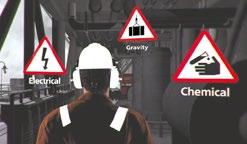
• Identify and manage hazards related to working at height


• Increase awareness of potential dropped objects and their effects

Wellbeing and Work Environment
• Improve understanding of physical and mental wellbeing
• Increase awareness of environmental health impacts
• Improve communication and better understand your colleagues
FACE2FACE ESR EVENT
After several years of online meetings, we were delighted to catch up with Elected Safety Reps in person at Aberdeen city centre venue Union Kirk. With guest speakers, engaging safety exercises, and networking & refreshments, a great day (& evening!) was had by all on what was also World Safety Day.
The agenda for the day included:
• Keynote Speaker - David Jamieson of Salus Technical
• ESR testimony & case study
• HSE - The importance of the safety rep function throughout Covid and into the new normal
• Workforce Engagement Support Team (WEST) interactive activities
• OIM - Use of SRE guidance

• Quiz, food & drinks
This event was free to attend and open to all member company safety reps, safety professionals and anyone with a passion for safety.
Thank you to all our speakers and to everyone who supported and attended. We look forward to the next one! Keep an eye out for the next dates for your diary or visit https://www.stepchangeinsafety.net/events/
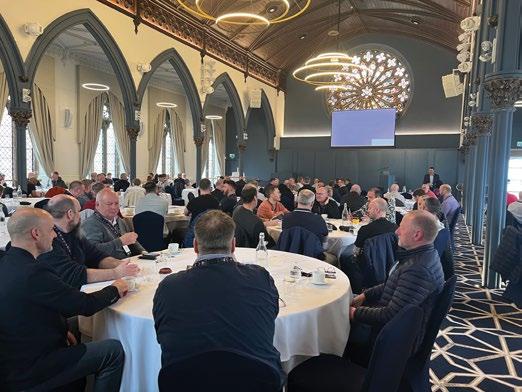
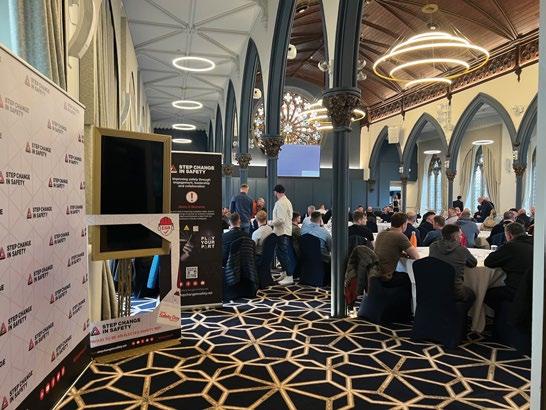
FUTURE EVENTS
Communication, collaboration and learning all help to improve safety. The events that Step Change in Safety deliver play a vital role in achieving this.
Through a series of events, forums and webinars, Step Change in Safety provide a platform for networking, learning and sharing knowledge about safety in the oil and gas industry. These events allow the workforce to play their part in improving safety by exchanging ideas and voicing concerns on issues that affect the whole industry.
SAFE LIFTING, WORKING AT HEIGHT, AND PREVENTING DROPPED OBJECTS SAFETY MOMENTS
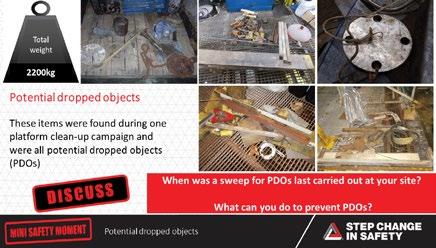
1. Mechanical Lifting
A short video of a lifting operation gone wrong and a reminder of the Safe Mechanical Lifting Life Saving Rule. Scan the QR code to view the video and remind yourself of the Safe Mechanical Lifting Life Saving Rule


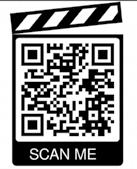
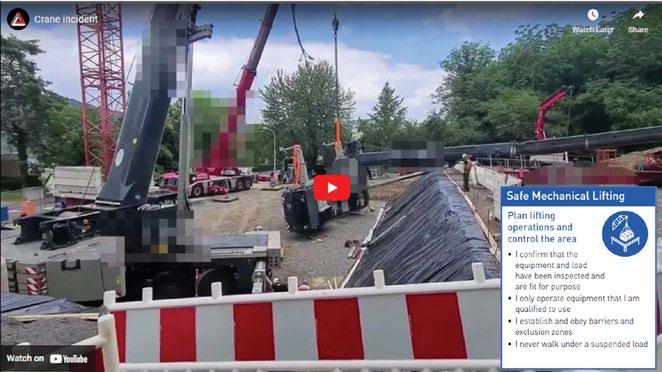
2. Working at Height
Failure to investigate, failure to learn
An engineer was working at height from a step ladder when he fell and injured his head and back. A second engineer restarted the task and also fell, sustaining similar injuries.
If the first incident had been properly investigated, the second engineer may not have suffered the same fate. Scan the QR code to find out more
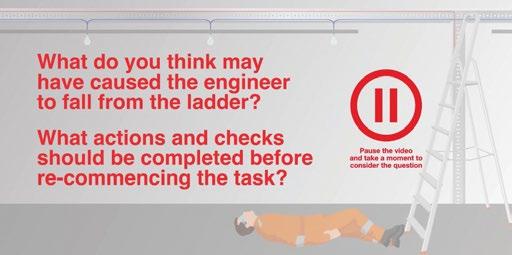
3. Prevention of Dropped Objects
Find more similar safety moments here by scanning the QR code
ENGINEERING SAFETY INTO EVERY FLIGHT
When a passenger steps on board a helicopter to travel to or from their work they can be sure that aircraft has been checked, scrutinised and cleared for take-off by expert engineers.
From pre-flight checks to post-flight examinations. From downloading data from on-board sensors to removing and inspecting components, every offshore aircraft is maintained to a strictly planned and monitored programme.
“Our engineering schedules are comprehensive and everything we do is carefully managed,” says Bristow’s Chief Engineer, Cameron Beattie. “There is a team of expert engineers working day and night behind the scenes that the passengers don’t see, and safety really is their only priority.”
“We operate a strict schedule of maintenance for every helicopter to ensure every aircraft gets the attention it requires – whether that’s a calendar inspection or due to the hours it has flown or flight cycles it has completed” says Cameron.
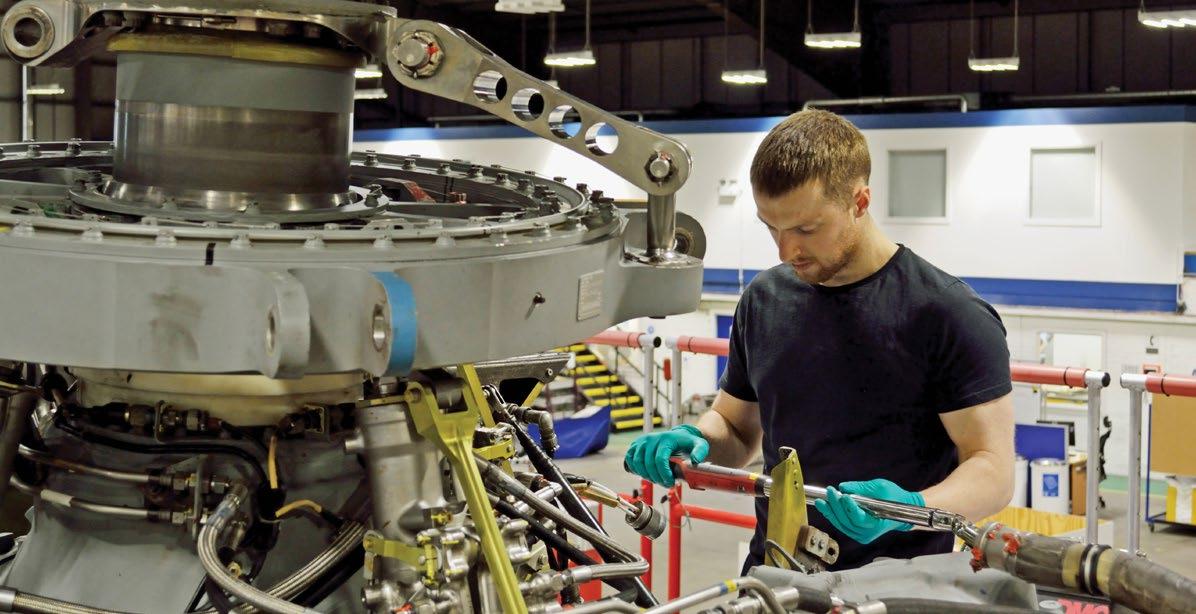
“It’s also really important our engineers are not pressured to complete a task within a deadline,” says Cameron. “We know how long certain jobs take, but if something requires more time, then it gets more time . This keeps their focus on the job, not the clock.”
Engineering and maintenance for offshore helicopters is largely split into two sections: ‘line’ and ‘heavy’. ‘Line’ tasks are the jobs that keep the aircraft operational every day. These range from daily inspections to a strip down of key assemblies like the main rotor head.
‘Heavy’ engineering covers the in-depth work that every aircraft is subject to after a certain amount of flying.
One key element of the line engineering process is analysis of the on-board Helicopter Usage Monitoring System (HUMS).
HUMS collects detailed information including systems performance and vibration levels from specialist sensors positioned across the airframe. The data are saved onto the aircraft’s memory card and downloaded by engineers every time the helicopter returns to base. It gives a unique view of its performance and behaviour, and anything unexpected is easily picked up by the engineers.
As well as routine daily examinations the line engineers carry out scheduled inspections of each aircraft.
At 1,500 flying hours aircraft are handed over to the heavy engineering team. Heavy maintenance of a helicopter
usually lasts between four to six weeks, during which time the aircraft isn’t available to fly.
“The amount of flying we do at Bristow means we expect our aircraft to go into the heavies hangar about every 14 months,” says Cameron. “There they get a very detailed inspection, with key components removed and checked. It’s also a moment when major parts can be replaced if the schedule requires.”
At Bristow the engineering teams operate in shifts, working round the clock, seven days a week to keep the fleet performing to the highest standards.
“I’ve been working on offshore helicopters for more than 40 years and while I’ve seen some incredible advances in technology, one thing that has never changed is the deep sense of responsibility. Every safe flight is a source of pride in a job well done,” says Cameron.
In this issue the TSN team caught up with Peter Rhodes at Worley.
Peter shares an insight into his day on the Judy, including his nickname earned by the team, conversations about cake and pudding and of course planning, vigilance and checks for this crucial aspect of offshore work.

A DAY IN THE LIFE
Recently I had the opportunity to assist on a J-Tube install on the Judy in the role of a rope access supervisor – an invaluable opportunity to both meet the people in our team and work to my own procedures. The questions for me were, could I remember how to be a good supervisor? Were my procedures any good? and could I cope with 3 weeks offshore?
Whereas in the past I’ve been a little nervous about fitting in offshore, I’ve been fortunate enough to have a few short trips on the Judy over the last year which meant that this time I was reacquainting with friendships I’d already made. In fact I even earned a nickname – Doc (apparently due to the fact that my hairstyle has a striking resemblance to Christopher Lloyd in Back to the Future!) – and surely a nickname shows that you’re one of the team!?
So what does a day look like for a Rope Access Manager trying to remember how to be a supervisor while also learning about offshore life? It starts early and the first challenge of the day is resisting eating too much for breakfast. Thankfully the 9am bacon roll makes this possible.
The morning meeting allocates the
work teams and the tasks for the day. On this trip we were using rigging underdeck but with lots of other trades working in the area or assisting us with the task, the management team offshore had their work cut out keeping everyone active and informed.
With the worksite and team assigned permits, planning is one of the key facets of a rope access supervisors duty. Rope access is a proven and established safe method of work, but this is exclusively down to the vigilance and planning that all the teams working with the technique apply.
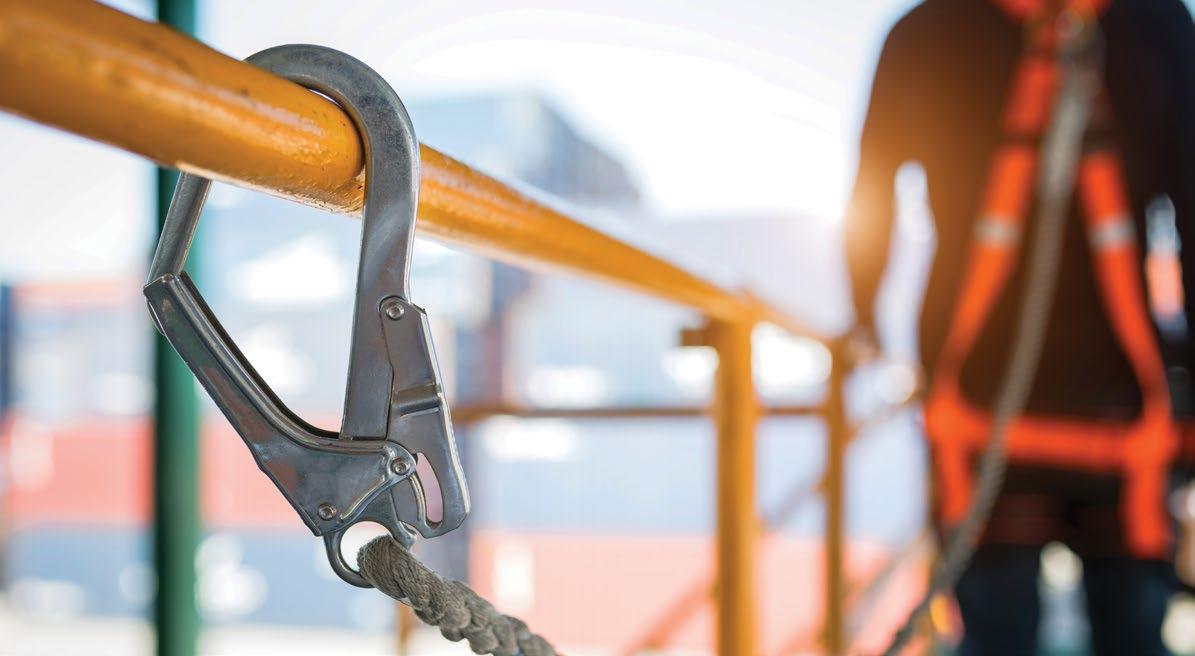
I’d discuss the work with the team and anyone that had worked in the area before to help make sure that every detail is covered in the work plan and equally important, the rescue plan. The rope access team has to be completely self-sufficient in this crucial aspect. This all then gets discussed in-depth at the toolbox talk on site to make sure that the whole team knows their duties and can spot any changes that might need the job stopped.
If I’ve done my job well then at the work site we go through the motions of the plan. I can’t help myself but make adjustments to people’s harnesses and
gear – the hands on nature has been developed from parenting 4 children, which in no way reflects the calibre of the people I work with!
Most of the time on site is spent watching and checking. We had a few guys doing rope access work for their first time and their confidence comes a lot from the Level 3s spending time with them explaining the set-up and monitoring their actions closely.
With days spent underdeck in the wind and shade the meals were what I found to be the mainstay of my spirits while on the platform – the discussion of cake and pudding choices taking up a disproportionate amount of our conversation!
I would encourage any who gets the opportunity to visit the jobs that so many of us are involved in planning. Gaining an insight into the offshore way of life is so important so that we can empathise with the guys and girls that we are asking to undertake these difficult jobs. And more than that, no one quite tells a story like a Glasweigan scaffolder in a tea shack – a life experience everyone should gain!
GENERAL KNOWLEDGE QUIZ
Keep your brain active with your own Sudoku quiz or grab a colleague or two and test your wits against each other in the general knowledge quiz. Over to you!
FEEDBACK & SUGGESTIONS
What can we do to continuously improve Tea Shack News? We want to hear from you!
Whether you have ideas for future articles which you think would be of interest to the workforce or want to shine a light on a specific matter which is relevant to your working day/shift or trip, we would love to hear from you. This is a publication created for you, so let us know what works and what doesn’t!
1. Which UK act won the Eurovision Song Contest in 1981?
2. What is the name of the final book in the Harry Potter series?
3. Which sign of the Zodiac is represented by the Scales?
4. What is the longest bridge in Great Britain?
5. Who is the voice of Shrek?
6. How many teeth does an adult human have?
7. What is the tallest building in the world and in which city is it located?
8. Which singer performed the songs ‘Lovely Day’ and ‘Lean on Me’?
9. What famous man became president of his country after being in jail for 18 years?
10. In which country did the Mojito cocktail originate?
11. What is the proper name for your funny bone?
12. Who directed the 1980 film adaptation of Stephen King’s horror classic ‘The Shining’?
13. In what year was the first Playstation console released?
14. In which county would you find Shrewsbury?
15. What is the strongest sense in humans?
16. Who was nicknamed the ‘Coughing Major’ after he was accused of cheating on Who Wants to Be a Millionaire?
17. What is the largest bird of prey in the world?
18. What is the most expensive painting ever sold?
19. What is the hottest chilli pepper in the world?
20. Which is the largest landlocked county in the UK?
Answers to the general knowledge quiz can be found by clicking this link or view at the bottom of this page, no cheating!
Got any interesting ideas or stories you’d like to share with the rest of industry? Anyone you’d like to recognise for being a safety champion?
Please get in touch with editor@teashack.news and we will consider it for future issues. We would also love to hear what you think about Tea Shack News Rebooted; all constructive feedback is welcome!


